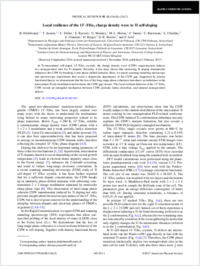Local resilience of the $1T\text{\ensuremath{-}}{\mathrm{TiSe}}_{2}$ charge density wave to Ti self-doping
- Hildebrand, Baptiste Département de Physique and Fribourg Center for Nanomaterials, Université de Fribourg, Switzerland
- Jaouen, Thomas Département de Physique and Fribourg Center for Nanomaterials, Université de Fribourg, Switzerland
- Didiot, Clément Département de Physique and Fribourg Center for Nanomaterials, Université de Fribourg, Switzerland
- Razzoli, Elia Département de Physique and Fribourg Center for Nanomaterials, Université de Fribourg, Switzerland
- Monney, Gaël Département de Physique and Fribourg Center for Nanomaterials, Université de Fribourg, Switzerland
- Mottas, Marie-Laure Département de Physique and Fribourg Center for Nanomaterials, Université de Fribourg, Switzerland
- Vanini, Fabiano Département de Physique and Fribourg Center for Nanomaterials, Université de Fribourg, Switzerland
- Barreteau, C. Department of Quantum Matter Physics, University of Geneva, Switzerland
- Ubaldini, A. Department of Quantum Matter Physics, University of Geneva, Switzerland
- Giannini, E. Department of Quantum Matter Physics, University of Geneva, Switzerland
- Berger, Helmuth Institut de Génie Atomique, Ecole Polytechnique Fédérale de Lausanne, Switzerland
- Bowler, D. R. London Centre for Nanotechnology and Department of Physics and Astronomy, University College London, United Kingdom
- Aebi, Philipp Département de Physique and Fribourg Center for Nanomaterials, Université de Fribourg, Switzerland
-
02.02.2017
Published in:
- Physical Review B. - 2017, vol. 95, no. 8, p. 081104
English
In Ti-intercalated self-doped 1T−TiSe2 crystals, the charge density wave (CDW) superstructure induces two nonequivalent sites for Ti dopants. Recently, it has been shown that increasing Ti doping dramatically influences the CDW by breaking it into phase-shifted domains. Here, we report scanning tunneling microscopy and spectroscopy experiments that reveal a dopant-site dependence of the CDW gap. Supported by density functional theory, we demonstrate that the loss of the long-range phase coherence introduces an imbalance in the intercalated-Ti site distribution and restrains the CDW gap closure. This local resilient behavior of the 1T−TiSe2 CDW reveals an entangled mechanism between CDW, periodic lattice distortion, and induced nonequivalent defects.
- Faculty
- Faculté des sciences et de médecine
- Department
- Département de Physique
- Language
-
- English
- Classification
- Physics
- License
-
License undefined
- Identifiers
-
- RERO DOC 288991
- DOI 10.1103/PhysRevB.95.081104
- Persistent URL
- https://folia.unifr.ch/unifr/documents/305565
Statistics
Document views: 138
File downloads:
- pdf: 193
